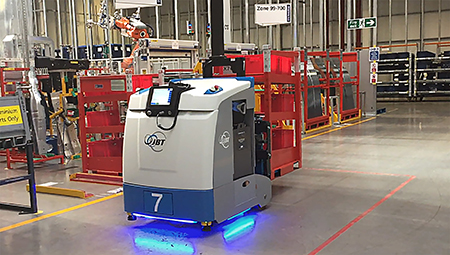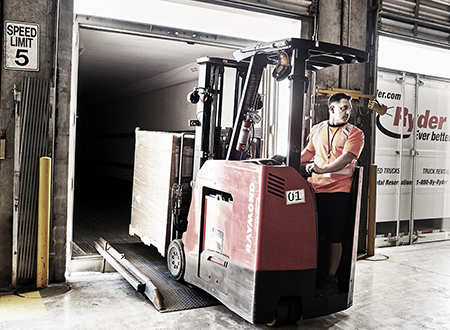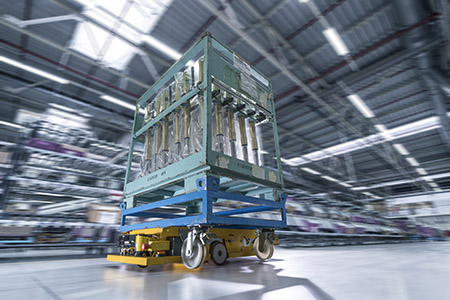 Ask automotive manufacturers what their primary concerns are today within warehouses and factories and they will probably allude to one of three key things – productivity, safety and waste. Although various solutions are available to help alleviate problems in these areas, one of the most important is materials handling technology.
Ask automotive manufacturers what their primary concerns are today within warehouses and factories and they will probably allude to one of three key things – productivity, safety and waste. Although various solutions are available to help alleviate problems in these areas, one of the most important is materials handling technology.
In recent years, such technology has improved production systems and inspired greater focus on automation across many manufacturing sectors. This has driven change both within automotive factories and warehouses and outside them, as sectors including e-commerce and retail have also looked to materials handling advances to improve their logistics performance, labour productivity and ultimately customer fulfilment.
For automotive logistics, a combination of pressure on costs, worker shortages and an ageing workforce have led to even more focus on automation in materials handling in recent years. According to Hugh Freer, a director at British tug and loading equipment maker MasterMover, many automotive manufacturers have been replacing traditional forklift trucks and other manually operated materials handling equipment with automated solutions. Existing systems often depend on an operator – including many types of equipment that require those using it to be licenced – and without that worker, the whole handling process is stalled, adds Freer.
Little wonder, perhaps, that manufacturers like BMW, GM, Audi and many others have been employing more advanced automated guided vehicles (AGVs) to support production processes.
Carmakers have already been using various types of AGVs for decades, and equipment providers say that they have done much to shape the direction and technology of such technology. Automotive managers tend to understand how such products work and often feed that back to their automated equipment suppliers to ensure more effective implementation – a critical point now that the automotive industry is so reliant on automation to support its production processes.

“In particular, the concept of ‘Industry 4.0’, which encompasses the trend of integrated automation and data exchange within manufacturing environments, seems to be transforming the way that [manufacturing] customers think about production,” says Mark Longacre, applications engineering manager at AGV provider, JBT Corporation. “We’ve noticed that those in the automotive industry are leading this trend. And since they’re technologically sophisticated customers, automotive producers are driving innovation from AGV suppliers.”
One good example cited by Noel Dehne, vice-president of sales at the automotive factory automation division of Daifuku America, is that of AGV companies partnering with forklift manufacturers to develop ‘dual-use’ industrial trucks, which can be either manually operated or switched to automatic, driverless mode.
Melonee Wise, chief executive of Fetch Robotics, meanwhile, suggests that autonomous mobile robots (AMRs) of the kind her company supplies are also becoming more popular, as they are easy to set up and flexible to reconfigure.
Automotive factories are also increasingly focused on safety and ergonomics in determining logistics automation. To reduce their employees’ injury risk, manufacturers are considering options like electric tugs, which single pedestrian operators can use to move upwards of 30,000kg of goods, says Hugh Freer, pointing to high level of handling-related injuries in the UK.
“At the same time, automotive manufacturers are also looking to decrease the usage of forklift trucks in pedestrianised areas,” Freer states. “Not only do they delay processes, but they can also pose a safety risk in the busy environment of an automotive factory.
“By using handling machines operated by a pedestrian, manufacturers are able to better control the load being moved around the factory, resulting in a much safer environment,” he adds.
ROI above all else?Increasing use of AMRs and AGVs is hardly surprising in an industry that has been happy to adopt static, multi-axis robotics technologies in manufacturing for years. Some suggest, however, that unrealistic expectations in terms of return on investment (ROI) have been holding back the take-up of such technologies.
“The ‘elephant in the room’ has been – and continues to be – the notion that unless automation can return the investment in 12 months or less, it can’t be justified,” Dehne says. “Automation is robust enough to last many years and flexible enough to be redeployed when processes change to provide a 10-15 year life. The need for a one-year ROI creates a bar so high that many very good ideas don’t get implemented.”
“Automation is robust enough to last many years and flexible enough to be redeployed when processes change to provide a 10-15 year life. The need for a one-year ROI creates a bar so high that many very good ideas don’t get implemented.” - Noel Dehne, Daifuku America
 Bespoke combinations of automated, semi-automated and manual solutions can now be provided thanks to safety advancements
Bespoke combinations of automated, semi-automated and manual solutions can now be provided thanks to safety advancementsDespite this, the use of automation in plants’ internal logistics, particularly those in the automotive industry, is growing, suggests Peter Mačuš, chief technology officer at automation solutions provider, CEIT.
Automation helps to provide efficient, reliable and safe logistics processes that can be monitored and optimised continually and easily, he points out. And as a result, he says, the future of automotive logistics lies in its automation.
“Numerous manual routines are performed by robotic devices and automation of internal logistics is a way to standardise processes and achieve higher productivity and lower costs,” Mačuš explains. “Of course, forklifts and standard handling equipment are still a stable part of automotive industry plants, but, for the sake of achieving greater safety, performance and reliability, the deployment of automated solutions is becoming a key factor.”
Mačuš believes logistics automation could be even more efficient still, if industrial plants’ planning, manufacturing and logistics processes were sufficiently interconnected.
“The deployment of automated logistics would be much faster if plants took it into account as early as during the planning stage,” he says. “To me, automated logistics means not only the transfer of material from point A to point B, but the automatic handling [loading and unloading] of material as well, especially in the automotive sector, where we deal with very extensive and complex internal logistics.”
Warehouse automationWhile automation in automotive manufacturing has been quite widely adopted, its use in warehousing has been rather patchier. But manufacturers should take a more holistic view of their businesses as they decide where automation is to be implemented, says Steve Richmond, director of logistics systems at Jungheinrich UK, a supplier of both automated and non-automated materials handling systems.
Using automation to implement a ‘goods-to-man’ process rather than the traditional ‘man-to-goods’ approach can help maximise output and accuracy in warehouse operations, he points out: such technology is now quite commonly used at picking stations where individual items are picked and presented to operators, for example, rather than them having to search for the right goods in the right quantities from the right locations themselves.
“A key driver for this is the enhanced safety systems that are employed in such solutions,” Richmond adds. “Ten years ago, this may not have been considered good practice, but it is now increasingly common to see direct interfaces between man and machine – a trend that is likely to continue in the coming year.”
[mpu_ad]Using a materials handling solutions provider to help decide how and where to automate, and where to leave things manual, can be of tremendous benefit, adds Richmond. “With the help of an intralogistics solutions provider, companies can assess and analyse where automation will benefit them the most,” he says. “When done correctly, there is also a place for automated solutions to sit alongside semi-automated and manual solutions as well, for a bespoke setup that caters to the exact nature of the business.”
Retail now sets the barTechnology adoption has historically been greater in the automotive industry than other sectors. The very first industrial robots, after all, were created for automotive manufacturing, lifting chassis and frames and placing them on assembly lines. Soon after, sensors were added, allowing robots to complete grinding, painting and welding applications.
“AGVs have been used in automotive manufacturing since the 1950s with advancements in technology coming from companies such as Volvo, which developed the first non-synchronous assembly equipment,” says Tom Kroswek, group director of product development and innovation at Ryder. “As a result of these advances, the industrial robots of today are capable of many assembly and manufacturing activities.”
However, automation has become increasingly important to other sectors, including on the customer-fulfilment side of operations, particularly for retail and e-commerce, especially as consumers’ expectations continue to increase. For example, not so long ago, next-day delivery was very popular; now the potential of ordering and receiving goods within an hour is not just attainable, but expected in some cases. As a result, large e-commerce companies must do what they can to meet their delivery challenges.
 Customers influenced by retail and e-commerce experiences are driving progress in materials handling in the automotive sector
Customers influenced by retail and e-commerce experiences are driving progress in materials handling in the automotive sectorLars Otte, vice-president of business development at Schnellecke Logistics, suggests AGVs and automated forklifts are easier to install in the retail and e-commerce industries than they are in the automotive industry, as such sectors tend to handle standard unit loads, like Europallet-based boxes. The automotive industry, on the other hand, features a high number of different types of containers, some of which are quite specialist, making implementation of automation more challenging.
“One other differentiator between automotive logistics and e-commerce and retail logistics is that automotive logistics is arranged around production, which is still seen as the key component of the industry’s success,” Otte adds. “However, in the e-commerce and retail industries, the ability to deliver to customers in a shorter timeframe is key instead.”
Gary Bobalik, director of marketing at Comprehensive Logistics Co, believes the retail industry has realised the full potential of such advances and set the bar in terms of consumers’ expectations in a way that other sectors, including automotive, must now follow – from the timeliness of new vehicle production and delivery to availability of service parts.
“The automotive industry has traditionally been an incubator of technologies,” he says. “But now that the retail industry has set the bar, the automotive industry must keep up in order to retain or grow market share.”
Automating the futureThe automotive industry’s extensive use of automation has transformed manufacturers’ views of their operations and made workers more comfortable with such technology than ever before.
 Humans are rapidly becoming more comfortable and secure in working alongside their ‘cobotic’ colleagues
Humans are rapidly becoming more comfortable and secure in working alongside their ‘cobotic’ colleagues“People are no longer afraid of AGVs. Instead, they recognise the tremendous potential of any kind of automation,” says JBT Corporation’s Mark Longacre. “Plus, as labour rates continue to rise and labour in general becomes harder to acquire, AGVs have developed into a strong alternative to traditional, manual materials handling methods. Implementing AGVs not only provides labour that is hard to come by, but also delivers a tremendous amount of savings to customers.”
Automation is now becoming even easier to deploy, points out Ryder’s Tom Kroswek – in particular using technologies like 2D lasers and 3D cameras to help AGVs to be truly self-guiding, rather than depending on some of the fixed guidance methods used in the past. “No wires, magnets, tape or reflectors are needed with this equipment,” he comments.
As customers’ expectations continue to rise, many expect manufacturers of all kinds to increase their use of automated technologies to streamline their processes and improve their supply chain efficiency.
As Steve Richmond of Jungheinrich UK points out: “With success stories and lessons learned coming out across a wide spectrum of industries, and with the changing nature of the assembly line – in which robotics and automation can be seen to increase speed, efficiency and safety – investment in automation is only set to rise.”
 BMW’s STRs use a combination of digital mapping and distance measurements to determine their position
BMW’s STRs use a combination of digital mapping and distance measurements to determine their positionAmong the OEMs leading the charge towards automation in production and warehousing have been German brands BMW and Volkswagen Group, including its premium subsidiary, Audi.
BMW’s exploits in this area include the recent deployment of a fleet of smart transport robots (STRs) developed in conjunction with the Fraunhofer Institute at its international parts packaging plant in Wackersdorf, as well as the use of autonomous tow tractors at its Dingolfing plant.
The STRs are used to autonomously transport containers of parts from handling to logistics areas, and use a combination of digital mapping and distance measurements generated by wireless transmitters to determine their position. The tugger trains at Dingolfing, meanwhile, are used for such tasks as bringing parts from an automated small parts warehouse to the sequencing centre in the right order for assembly.
BMW has already announced plans to roll out both technologies at other plants in Germany and elsewhere.
Among Volkswagen’s forays into the field of automation, meanwhile, has been the introduction of a new ride-along platform to help workers at its Wolfsburg plant carry out sequenced parts picking.
The system, which consists of a mobile platform that transports workers from one shelving area to the next, based on a pick list they simply scan in as they begin picking, automatically moves them to the required picking point, where an LED shows the worker which side to pick from. A beam of light is then projected onto a compartment in one of two trolleys hooked up to the platform to show the operator which bin to deposit the parts in. Materials being loaded are scanned to ensure they are deposited in the right location.
VW was planning to put four more platforms into operation by the end of 2017, as well as to implement the technology at a number of other VW brand sites.
[related_topics align=”right” border=”yes”]Audi, meanwhile, has not only trialled a wide number of new technologies, including drones and smart glasses, but more new types of equipment are being used in serial production. Advanced, self-navigating AGVs are now in use for various functions at the carmaker’s German plants in Ingolstadt and Neckarsulm. Meanwhile, the company’s own engineers are developing several types of advanced AGVs capable of machine learning.
Also at Ingolstadt, a new supermarket concept is being rolled out to serial production that includes a ‘goods-to-man’ approach using AGVs and various ‘pick by’ assistance systems for kitting.
Topics
- Audi
- BMW
- BMW
- CEIT
- Comprehensive Logistics
- Daifuku America
- Digitalisation
- Europe
- features
- Fetch Robotics
- Fraunhofer Institute
- Germany
- JBT Corporation
- Jungheinrich
- Logistics Automation
- MasterMover
- Materials handling
- North America
- Packaging
- Plant Logistics
- Ryder
- Ryder
- Schellecke Logistics
- United Kingdom
- United States Of America
- VW


























![Global[1]](https://d3n5uof8vony13.cloudfront.net/Pictures/web/a/d/s/global1_726550.svgz)









